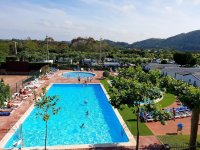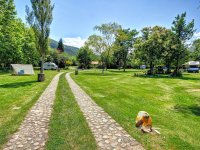Given the vast majority of those making use of Brittany Ferries’ year-round service to northern Spain immediately head south upon disembarking at Santander, it would be easy to assume that there’s not much worth seeing nearer to port. This does a huge disservice to regions abundant not only in culture and history, but also natural beauty and culinary delights. Which is why we had decided to stay and explore Cantabria.
ROAD TO JOY
Having had the pleasure of watching dolphins swim alongside our inbound ferry at daybreak, we left the city of Santander behind to head east along the Costa de Cantabria. Our first stop is the wonderful Playa Joyel, A campsite that not only has one of the best locations in all of northern Spain, but also boasts its own on-site farm and nature park – two key reasons our kids Harrison and Dorothy wanted to stay here.

While Santander – with its bustling markets, Gothic architecture, excellent museums, art exhibitions and gastronomic hotspots – is only a short drive away, none of us feel instantly compelled to leave the immediate area, especially given what’s on offer. The site has direct access onto Playa de Ris, one of the best beaches in all of Cantabria, as well as the equally beautiful Playa Cuarezo. The children are soon running carefree across the golden sand, my partner Kim and I content to have the warmth of the sun on our faces and the sound of their laughter carried on the breeze.
Our trip is out of season, meaning we practically have the beach to ourselves, bar a few surfers making the most of the rolling waves. We've been informed that during low tide it's possible to walk out to Isla de San Pedruco, a small islet that sits at the eastern end of Playa de Ris (make sure you check tide times before you set off). As is often the case on our adventures, the children lead the way, eager to discover what lies ahead. We scramble up the rocks after them, eventually catching up as they reach the high point of the little islet, from where we are able to marvel at the views.
Back at the campsite the excitement levels remain high as our stay coincides with one of the twice-weekly openings of the site’s farm to guests. What’s more, we are actively encouraged to join in with the feeding of the animals, and so we fall in behind two wardens wheeling in a huge cart full of stale bread and vegetables.

It’s not long before we are surrounded with an assortment of (largely tame) animals, including goats, sheep, emus, water buffalo, long-horned cows and peacocks, all eager for their share of the spoils. Harrison and Dorothy delight in the chance to be so close to them, but are a little surprised at how cheeky some of them are, nosing at their pockets in search of any hidden treats.
As is the case with young children, it’s not long before they are the ones wanting feeding, and so we take the short walk into Noja. Being a coastal village, the cuisine is heavily influenced by the sea, with the focus very much being on fresh seafood and traditional Cantabrian dishes such as cocido montañés (a traditional stew of pork, beans and greens). It’s not long before our table is a riot of sumptuous sharing dishes, accompanied by the happy sound of the children enjoying their food, set against the backdrop of a slowly setting sun.
HIGHBROW BILBAO
There is one major pull away from the immediate area, and that is Bilbao’s iconic Guggenheim Museum, frequently described as one of the most important buildings of the 20th century – and not without good reason. It’s hard not to stop and marvel at Frank Gehry’s curvy, silver goliath of modern architecture. There is a danger with children that certain museums and art exhibitions won’t excite and engage them, but this was not the case with the Guggenheim.

From the moment we arrived they were in their element, especially when Dorothy saw Jeff Koons’ Puppy outside the building, towering over us, resplendent with multicoloured flowers – her only disappointment being that it wasn’t actually real. Inside, it’s Richard Serra’s sculptures that fascinate the four of us the most. It’s hard not to feel small against these vast curved steel sculptures known as The Matter of Time. What we have always loved about art is how subjective it is, always open to personal interpretation, and so it fascinates us to see the exhibitions through the eyes of the children, understanding how they see the amazing array of works on display.
Our day in Bilbao finishes with a ride up to the top of Mount Artxanda in the funicular, a mode of transport that always pleases the children. From here we are afforded sweeping views across the city, and the chance to see the Guggenheim in all its majesty. It’s standing here, listening to the excitement in their voices as they relive their favourite moments from the day, that Kim and I are reminded that the real joy of travel is not always the destination, but the moments that we create together.
INTO THE SLOW LANE

That said, the next stop on our visit marries both the beauty of the destination as well as the good times we created there. After the hustle and bustle of Bilbao the contrast of the utter tranquility to be found at El Molino de Cabuérniga couldn’t be more stark. Set in the Cabuérniga Valley, with the Picos Europa mountains to one side and the Saja River to the other, this is the perfect campsite for those looking to escape into nature.
For us this meant exploring on two wheels and two feet, making the most of the abundance of hiking and cycling trails that criss-cross the valley and surrounding peaks – although Dorothy was left wishing she was riding one of the magnificent horses in the fields by the campsite. Not that it deterred her from leading the charge on our daily hikes, driven on by the eternal hope of catching a glimpse of the elusive Cantabrian brown bear.

Exploring the landscapes that surround the campsite, meandering through local villages, eating in traditional restaurants and listening to tales from locals gave us an insight into the rich cultural heritage that abounds in this corner of Cantabria, opening our eyes to a more simple way of living, one that is in keeping with the natural rhythms of nature. While each day brings a new adventure, there is a slowing down, with which comes an appreciation of the small things, the ability to see beauty in the minor details of the everyday. It’s a lesson that holds true for all of life; that we should all slow down a little and appreciate the world around us.
It’s with this thought in mind that we eventually say hasta luego to Cantabria, grateful for the family memories created and the chance to explore a region of Spain that ought to be everyone’s first port of call once off the ferry.


